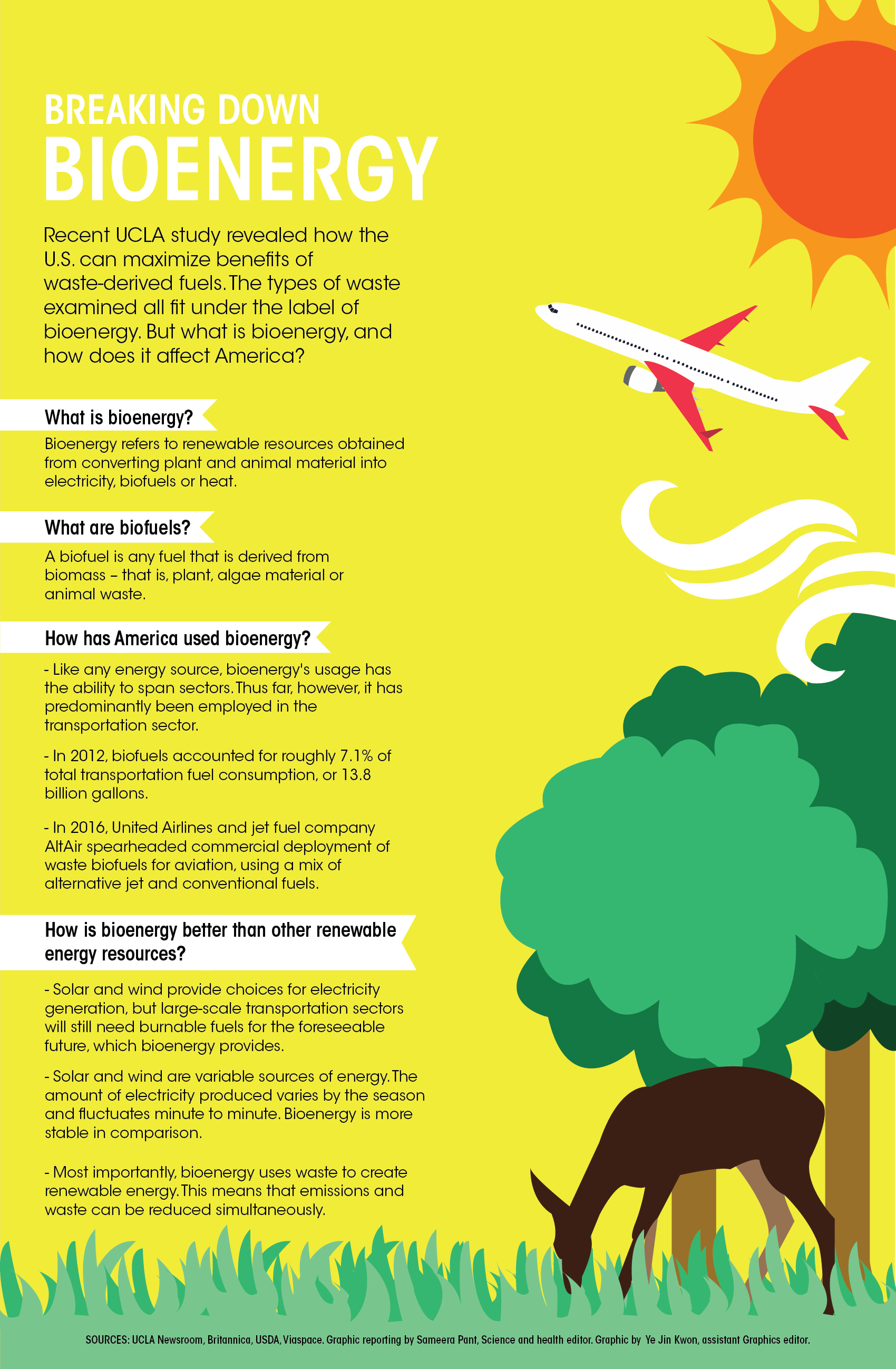Study examines how waste can be used for bioenergy, potentially on national scale


By Sameera Pant
Sept. 20, 2019 1:11 a.m.
A UCLA study found that harnessing the nation’s waste could potentially produce large amounts of energy and cut greenhouse gas emissions.
One of the study’s key conclusions was that employing all available wastes in the contiguous United States to create bioenergy could possibly generate 3.1 to 3.8 exajoules of renewable energy. According to the study, which was published in Nature Energy, this was around 3.7% of total U.S. energy demand in 2016.
Although the percentage is in the single digits, this signifies an enormous amount of energy. This amount of generated energy would be able to power upward of 82 million American homes, according to 2017 statistics from the United States Energy Information Administration.
The study first started as a project funded by the Sustainable LA Grand Challenge, a plan for Los Angeles County to attain 100% renewable energy, 100% locally sourced water and better ecosystem and human health by 2050.
Although it began at a city level, the study’s scope was eventually expanded to examine how to utilize waste on a national scale, covering every county, said Bo Liu, first author of the study and urban planning graduate student.
The study’s overarching aim was to examine how waste can be turned into various sources of bioenergy. Bioenergy refers to biomass-based energy, or energy produced from plant matter, said Deepak Rajagopal, study co-author and associate professor at the UCLA Institute of the Environment and Sustainability.
“It can be crops, it can be agricultural refuse, it can be cow dung,” he added.
Traditionally, humans treat waste as a leftover, whether from food or households. However, waste-based fuels are actually cleaner than the more commonly seen alternatives of wind and solar energy. These energy sources still use fossil fuel to generate the material used when building their plants, as well as in the transporting of materials from one site to another, Liu said.
The study examined variations of biomass, all falling in four broad categories of agricultural residue, landfill waste, forestry and animal manure, drawing upon the fields of industrial ecology and energy economics.
Industrial ecology works toward developing human economies which mimic natural economies like a food chain, Rajagopal said. Conversely, energy economics refers to the economic analysis of energy production, supply and consumption.
Life cycle assessment, a framework that takes a comprehensive look at the entire life cycle of a product, served as the study’s primary methodology, Rajagopal said.
Such an assessment could be undertaken for anything, he said. For instance, for the life cycle of a computer, you look at all the components that go into the computer, where they are made, how much energy it takes to use the device and then what happens at the end of it all.
“If you’re looking at biomass, you’re looking at the energy required to make biomass, the energy harvested (from it), the energy required to process it, and then transport again to the final consumer, and the pollution that comes out,” Rajagopal added.
The study employed this approach in its analysis of 29 types of waste and 15 energy conversion technologies. Since the study was nationwide, Liu relied on R, a programming language used for computing statistics, to write a script that would analyze the data of every county.
When executed, the program connects each county with the most effective technique to convert its waste to energy, depending on whether the county hopes to produce more energy or reduce greenhouse gas emissions.
The program consists of and connects two types of databases: waste resource databases and technology databases. The former delineates the types and quantities of waste available in each county, while the latter was developed from reviewing literature on waste-to-energy technologies that had been tested in labs, like the conversion of sugar extracted from agricultural residue into bio jet fuel.
Estimations of energy production and possible emissions of these processes were also integrated in the script, Liu said.
Another key finding of the study was how the employment of nationwide bioenergy production would lead to climate benefits and gains in net energy, or the amount of usable energy generated after a fuel is converted to power.
Additionally, using bioenergy would reduce the release of greenhouse gas emissions because waste would be used to create energy instead of being transported to landfills, Liu said.
Liu said this idea of generating large amounts of energy from waste could serve as a starting point for new energy policies. The goal for this program is to ultimately support policy making on waste management and bioenergy, he added.
“What we’ve done here is sort of like a first step,” Liu said. “Before (policymakers) even think about using waste on a larger scale, they probably want someone to do an assessment to look at the potential of using those wastes.”
The second step would be to look at the impacts of waste-driven fuels, Liu said.
Thus far, the study’s research looks at how waste-based fuels could produce energy and help the environment. However, impacts of waste-driven fuels on air and water quality must also be done to understand the possible effects this method of energy generation may have, Liu said.
Waste-driven fuels also target reducing the waste already produced and sent to landfills, Liu said.
“There must be a way to deal with landfills,” Liu said. “If a landfill reaches capacity one day, what will be done with all of its waste?”
Since the study only linked waste-to-energy technologies with the types of wastes, comparing these waste-based technologies to other renewable energy sources may require further investigation, Liu said.
He added that the model was purely computational, so the databases could be adjusted to those of other countries.
“It needs some work in order for it to be applicable to other regions, but it’s totally doable,” Liu said.
Ian Wahagheghe, a second-year environmental science student, said although he thinks waste-driven fuels are a good alternative, people may not be as receptive to such energy sources at first.
“It’s going to be hard to be accepted by the public in the short term just because they’ve adjusted to more standard means of energy production, such as oil or coal,” Wahagheghe said.
Wahagheghe added that to the average person, waste-based fuels may be thought of as unsanitary because of unwanted fumes or smells, despite them being environmentally “cleaner.”
Additionally, people may prioritize lower costs over environmental consciousness, as more tried-and-tested methods of energy production may be cheaper, Wahagheghe said.
“Energy production through waste burning would be more expensive,” Wahagheghe said. “If (people) have to pay more to get the same result, again, it goes back to the public not wanting to accept it.”


